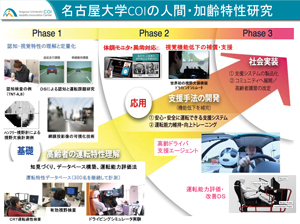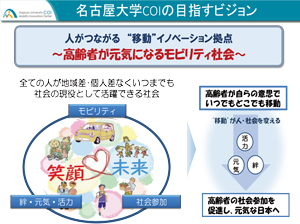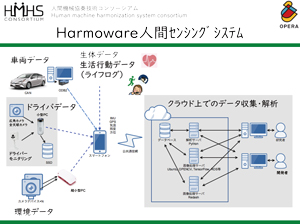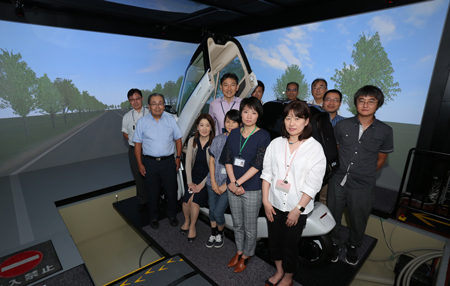| He also performed visual simulation using VR in his study (1990-2000 fiscal years) on the relationship between the spatial shape and a sense of direction (spatial perception) in the space station (gravity-free environment). Utilizing the functions of VR capable of expressing weightlessness such as being visually upside down, he also did studies on designing space stations.
Furthermore, in MIT, he performed joint research with NASA on application of VR simulation to astronaut training for spatial recognition ability (2004-07 fiscal years). Checking a sense of direction of the test subject in advance and taking measures for it, training effects of VR were recognized.
In 2007, he joined Toyota Motor Corporation, as he had been wanting to "do what is related to actual products" while being involved in such studies that are related to human beings for long time.
His wishes and expert were coincided with the timing asked for by the Company. In addition, the world's largest DS was just introduced in the Higashi-Fuji Technical Center of the Company with Mr. Takashi Yonekawa (currently Professor, Transportation and Social Systems, Green Mobility Research Institute, Institute of Innovation for Future Society, Nagoya University) as the core staff. It also motivated him to be able to use it.
Since then, Prof. Aoki has been working on diverse basic researches using the DS, experiencing processes of productization. For example, in relation to Pre-Crash Safety System (PCS), he formulated different braking timings depending on drivers based on individual characteristics of vision towards preventing rear-end collision, and proposed this as the index of the perceptual risk estimate "PRE". He measured and evaluated the effects for the case of putting it into the real control using DS and actual vehicles. Its results have been adopted in the Company’s PCS since 2012.
Towards Study on Hallmarks of Aging with Nagoya Univ. COI as Its Base
When he was thinking of returning to the academic community again after productization of the research results as an opportunity, Nagoya Univ. decided to start up "Nagoya Univ. COI" after the Univ. adopted "Project to establish centers for international scientific innovation using regional resources based on industry-academia cooperation (fiscal 2012): joint application with Aichi pref., Toyota city, and Toyota Motor Corporation". Prof. Aoki moved to the Univ. and joined the start-up.
The vision of Nagoya Univ. COI is construction of "Mobility Society
to Help the Elderly to Lead to Active and Joyful Life" under the philosophy
of "Mobility Innovation Center for people to get connected".
The research systems of the COI project are composed of the following 5
areas:
- 1) Research on mobility,
2) Research on information platform,
3) Research on daily healthcare platform,
4) Research on sustainable platform,
and 5) Research on cooperative areas.
Among them, Research on mobility is composed of researches on three areas
- 1) Intelligent mobility,
- 2) Human factors and aging characteristics,
- and 3) Transportation and information systems.
Research on Human factors and aging characteristics are conducted by 2
groups: Supporting Method Development Group "Human Factors and Aging
Group" led by Prof. Aoki.
It was decided to establish NIC at the same time with the start of Nagoya Univ. COI. For the specification process towards its construction, some frameworks were envisioned such as "DS is also necessary for it as a research base for mobility", as well as "let's create the first DS in the world with such specifications that allow various researches". The details were examined mainly with Professor Tetsunori Haraguchi, vice-director of GREMO of the Univ., Prof. Yonekawa, and Prof. Aoki, and two requisites were settled: 1) Stereoscopic vision with excellent rendering such as a proximity sense to preceding vehicles, and 2) high resolution (4K) capable of correctly representing shapes of vehicles etc. that are approaching gradually from the far.
Aiming at realizing a society where the elderly can live actively by extending healthy life expectancy and driving life, "Human Factors and Aging Lab" is working on construction of a human characteristics database including physical characteristics and the cognitive function of the elderly to contribute to developing driving support technologies to be required there. Its activity involves about 50 members with 15 members as its core and including the members who participate joint researches from inside and outside the Univ.
The Lab currently puts emphasis on collecting basic data about the cognitive function, visual function, and motor function in the elderly, which change along with aging. This is for creating a basis for investigating causality between accidents involving the elderly and characteristics of the elderly. In specific, using various kinds of equipment for measuring and checking different functions including DS, the Lab continuously acquires data from the same people every year with the help of about 300 elderly people. The lab got 100 of them to mount a dashboard camera recorder in each of their privately-owned cars to record their daily driving. They are designed to allow each function to be associated with driving characteristics.
|
|
 |
 |
 |
Research contents of Human Factors and Aging Lab.,
Green Mobility Research Institute |
|
| Another activity that Prof. Aoki puts emphasis on is Human Machine Harmonization System consortium (HMHS). It is adopted in "Program on Open Innovation Platform with Enterprises, Research Institute and Academia (OPERA)" (Japan Science and Technology Agency), and 4 public research institutes including Nagoya Univ. participate in it. It aims at studying "Harmoware", a platform for human beings and intelligent machines to provide services in harmony and developing applications that operate on the platform. He and others cooperated with each other in extending the automated driving OS originally developed in Nagoya Univ. into Harmoware, obtaining the data while driving and drivers' data in real time, and processing them in the cloud. He says he would like to share its advantages not only in driving scenes but also in a wide range of working or living scenes. |
Development, Utilization, and Future of a Large Five-Screen 3D Stereoscopic DS
"It was FORUM8 who presented the best solution when we said were going to produce the world's first 4K 3D Large-scale DS", says Prof. Aoki.
"However, since it is the first in the world, we have been creating it jointly with FORUM8 in some sense. Currently we are also evolving it together. In this sense, they are a reliable partner."
In 2013, in preparation for the Nagoya Univ. COI project and establishment of NIC, functional requirements for the new DS were determined. Based on this, DS of multiple companies were compared and examined. It was decided to develop the new DS based on UC-win/Road of FORUM8. After NIC was completed in April 2015, "Vehicle performance demonstration system: high-precision DS" (4K, 3D CAVE, 6DOF) was delivered in June, which is the first large five-screen 3D stereoscopic DS in the world with advanced sensations of approach and immersion.
The DS is installed in the Driving Simulator Room in Vehicle Bench
Test and Characteristic Evaluation Laboratory on the first floor of NIC.
To realize driving and vehicle traveling simulation in a full-scale VR
space, the DS installed in the center of the room is surrounded by large
screens like walls, with another screen on the floor. 20 units of personal
computers are used in total in order to display images on respective screens
using rear projection.
|
|
The DS is capable of representing the symptom of visual field defects caused by glaucoma realistically, for example. It makes it possible to see its influences on driving operation such as lane keeping or following the preceding vehicle. In addition, tests are also conducted using DS regarding the conditions that cause error of erroneously stepping on the accelerator pedal and the brake pedal, which has become a problem in recent years, and the driving behavior that follows after such an error has occurred.
In the future, he is further planning to expand its supporting functions to cover other visual disturbances such as age-related macular degeneration and cataract, as well as such events as sudden running out of a pedestrian etc. or oversight of signals.
|
|
 |
| Members of Human Factors and Aging Lab., Green Mobility Research Institute |
|
|
|
Large 4K Five-Screen 3D Stereoscopic Driving Simulator FORUM8 delivered it to Nagoya Univ. as a DS for research and development of vehicle performance demonstration in 2015 |
|
|